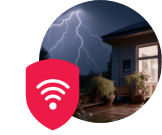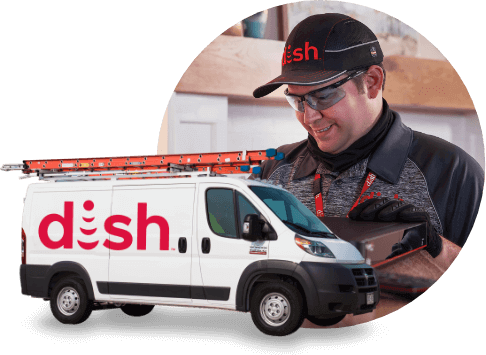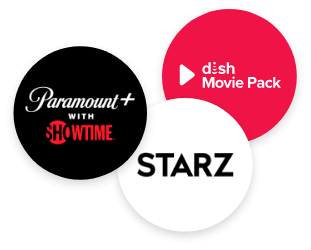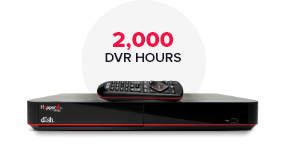The Best Internet Speed for YouTube TV to Kill Buffering
Table of Contents
The popcorn is ready, the milk duds acquired, the couch is fluffed, the kids are in bed, and it’s a little stormy outside. This is officially the perfect setup to binge-watch all eight Harry Potter movies, currently streaming on NBC via YouTube TV.
You snuggle under your blanket, content for a long night of wizards and wand waving. You’re ready to witness Harry’s journey from the cupboard under the stairs to defeating He-Who-Must-Not-Be-Named. And then…the unthinkable. Instead of the iconic Warner Brothers logo with moody music signaling the start of Harry’s journey in Sorcerer’s Stone, you’re met with a black screen of buffering death (not courtesy of Voldemort, but somehow just as soul-sucking as a Dementor’s kiss).
If you’ve experienced something similar, you understand the frustration of a perfect movie night being ruined because your internet speed isn’t up to snuff with your YouTube TV service requirements. It’s worse than getting a Howler from Mrs. Weasley or being stuck in detention with Professor Snape—at least those eventually end.
Don’t worry, we’re here to make sure you can watch Hermione save Harry more than a time or two, Ron face his fears, and Neville become a hero, all without the annoyance of buffering interrupting the magic. Read on to get the full rundown on internet speed for YouTube TV, top providers for best speeds, and how to ensure your streaming experience is more reliable than a Time-Turner.
[search_block]
Basic Requirements for Internet Speed for YouTube TV
YouTube TV has specific speed requirements that vary dramatically based on what you’re watching and how you’re watching it.
A minimum internet speed of 3 Mbps is required for standard-definition (SD) streaming. High-definition (HD) content requires 13 Mbps, and 4K content demands at least 25 Mbps per stream [1].
Remember, these are just the baseline requirements. Think of these numbers as the bare minimum to get your content playing, not necessarily for the best experience.
Why You Need More Speed Than You Think
Most households don’t just stream on one device at a time. You need speeds of only 13Mbps to stream one show on YouTube TV in HD, but most people use their internet connection for more than one activity at a time—think mobile phones, smart home gadgets, laptops, gaming consoles, and more.
Calculating Your Household’s Total Bandwidth Needs
Each device connected to your router consumes a portion of your available internet speed. For instance, if one device streams in 1080p HD, it typically requires at least 13 Mbps, while another device streaming in standard definition (SD) needs approximately 3 Mbps. Combined, these two streams would demand a minimum of 16 Mbps to ensure uninterrupted playback.
A household with four devices streaming in HD simultaneously could require more than 52 Mbps of consistent speed to maintain a buffer-free experience. This doesn’t even account for other internet activities happening simultaneously, like video calls, online gaming, or file downloads.
Smart Recommendations for Multi-Device Households
A 100 Mbps internet service can stream 5 4K YouTube TV streams at once. If your household has fewer than 5 TVs that will be streaming simultaneously, we recommend starting with a 100 Mbps connection. This provides a comfortable buffer for other internet activities, ensuring consistent performance even during peak usage times.
For households with heavy internet usage, consider these guidelines:
- 2-3 simultaneous HD streams: 50-75 Mbps minimum
- 4-5 simultaneous HD streams: 100-150 Mbps recommended
- Multiple 4K streams plus other activities: 200+ Mbps ideal

Fiber and cable are the best options
Why Internet Type Matters for YouTube TV Performance
The type of internet service you have can significantly impact your YouTube TV experience, regardless of the advertised speeds.
Fiber Internet
Fiber internet is the top-tier choice for high-speed internet and reliability. Fiber delivers several key advantages for streaming:
- Consistent speeds regardless of peak usage times
- Low latency for responsive live TV viewing
- Symmetrical upload speeds (great if you stream content yourself)
- Superior reliability in various weather conditions
Cable Internet
Cable internet offers higher speeds and greater bandwidth than DSL, making it a good choice for tech-savvy families and those working from home or engaging in data-intensive tasks. It’s ideal for households with multiple users and devices, supporting activities such as streaming HD and 4K videos.
However, cable internet has some limitations:
- Cable internet might slow down during busy hours of the day/evening
- Speeds can vary based on neighborhood usage
- Upload speeds are typically much slower than download speeds
DSL and Satellite
DSL and satellite internet are slower and may choke on high-quality streaming, especially during peak times. DSL provides wider availability, especially in rural areas, but it struggles with the demands of modern streaming.
DSL limitations for YouTube TV include:
- Maximum speeds typically around 100 Mbps (often much less)
- Speed decreases with distance from the phone company’s equipment
- May struggle with multiple HD streams or any 4K content
What’s Hot on YouTube TV Right Now
YouTube TV’s extensive channel lineup delivers some of the most popular content across live TV, sports, and entertainment. With over 100 channels, including major networks like ABC, CBS, NBC, Fox, ESPN, CNN, and premium add-ons, there’s always something trending to watch [2].
Must-Watch Live Sports and Events
Sports fans are flocking to YouTube TV for exclusive NFL Sunday Ticket access, making it the ultimate destination for football season. With 46 dedicated sports channels, including ESPN, ESPN2, Fox Sports, NBC Sports, CBS Sports Network, and regional networks, you can catch everything from NFL games to March Madness, NBA playoffs, and MLB action [3].
The platform recently gained attention for offering Super Bowl coverage in 4K through its 4K Plus add-on, drawing massive viewership spikes that put internet connections to the test. Popular live sports currently drawing huge audiences include NFL preseason games, The Basketball Tournament, and ongoing MLB season coverage.
Trending Network Shows and Live Programming
YouTube TV subscribers are binge-watching hit shows across its network lineup. Popular current programming includes Survivor and Big Brother on CBS, live news coverage on CNN and Fox News, and primetime dramas on ABC and NBC. The platform’s unlimited DVR feature means viewers can record everything from The Bachelor to Saturday Night Live without worrying about storage limits.
Comedy Central’s lineup draws significant viewership, while channels like Bravo, Food Network, and HGTV provide endless entertainment for different demographics. The recent addition of premium add-ons like HBO Max, Showtime, and Starz gives subscribers access to blockbuster content alongside live TV.

Set yourself up for streaming success
Optimizing Your Network for YouTube TV Success
Getting the right internet speed for YouTube TV is only half the battle. How you set up and manage your home network can make the difference between smooth streaming and constant frustration.
Wi-Fi vs. Ethernet
Connecting via Ethernet is generally considered superior to connecting via Wi-Fi. Most devices connect over Wi-Fi these days. Usually, it works great! But if you want bulletproof connectivity for watching YouTube TV, use an Ethernet cable instead. An Ethernet cable provides a much stronger and more stable connection.
When to choose Ethernet:
- For your main TV or streaming device
- When experiencing frequent buffering issues
- For 4K streaming on large screens
- In households with many competing wireless devices
Router Placement and Network Optimization
Place your Wi-Fi router in a central location for better signal coverage.
Key router optimization tips:
- Position the router in an open, central area
- Keep it away from walls and metal objects
- Avoid placing near other electronics that cause interference
Troubleshooting Common YouTube TV Streaming Issues
When YouTube TV starts buffering, try these immediate solutions:
- Check Your Speed First: Use our internet speed test to check your connection speed. Ensure that it meets the recommended internet speed for YouTube TV without buffering.
- Restart Everything: Power cycling your devices can often resolve persistent buffering problems. To do this, turn off your devices and unplug them from the power source. Wait for a few minutes, then plug them back in.
- Adjust Video Quality: If your Internet speed is lower than the recommended speed, adjust the video resolution to a lower setting (e.g., 480p or 720p). This will reduce the strain on your connection and prevent buffering.
ISP Throttling
ISP throttling, or bandwidth throttling, is used by Internet Service Providers (ISPs) to regulate network traffic and minimize bandwidth congestion. This includes intentionally slowing down the internet speed of a particular user, a particular service, or at certain points throughout the day or night.
Signs of potential throttling include:
- Frequent buffering when streaming, despite high-speed internet plans
- Noticeable speed differences between different online activities (i.e, slower when streaming or downloading files vs. browsing the internet)
- Consistently slower speeds during peak evening hours
You can check for throttling by using our speed test at different times of the day and for different activities. If your internet is significantly slower during certain activities or times, you may be experiencing throttling.
Determining Your Data Usage
YouTube TV uses about 1 GB of data per hour for standard definition. HD streaming can use 3–4 GB per hour, while 4K can use up to 7–10 GB per hour. These numbers add up quickly for heavy viewers.
Monthly data usage examples:
- Light viewer (1 hour SD daily): ~30 GB per month
- Average viewer (2 hours HD daily): ~240 GB per month
- Heavy viewer (4 hours HD daily): ~480 GB per month
- 4K enthusiast (2 hours 4K daily): ~600 GB per month
Streaming video is one of the most data-intensive things you can do online, so look for a service that has a high data cap or, preferably, an internet plan with unlimited data.
Calculate your data usage here.
Your Path to Perfect Streaming on YouTube TV
YouTube TV offers an excellent cord-cutting experience when paired with the right internet connection. By understanding your household’s specific needs, choosing the appropriate internet type and speed, and optimizing your home network setup, you can enjoy buffer-free streaming that rivals traditional cable TV.
Remember, the best internet speed for YouTube TV isn’t just about hitting minimum requirements—it’s about ensuring consistent, reliable performance that enhances your viewing experience rather than detracting from it.
Find the Perfect Internet Provider in My Area Now!
Ready to upgrade your internet speed for YouTube TV so you can enjoy your movie nights (finally)? The first step is discovering what high-speed options are available in your specific location. Find internet providers near you to discover plans and deals available in your area by entering your zip code below.
[search_block]
Compare speeds, prices, and plans specifically designed for households like yours that stream. Whether you need budget-friendly options for basic HD streaming or blazing-fast fiber for multiple 4K streams, you’ll find the perfect match for your YouTube TV needs.
Sources
[1] Support.google.com. “YouTube TV Answers"
[2] Tv.youtube.com. “Directory"







 Call
Call 

 Access Your Account
Access Your Account